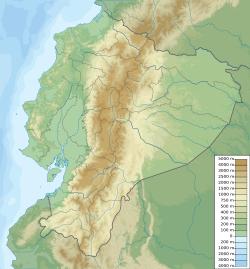Cordillera del Cóndor facts for kids
Quick facts for kids Cordillera del Cóndor |
|
|---|---|
| Highest point | |
| Elevation | 2,950 m (9,680 ft) |
| Dimensions | |
| Area | 25,857 km2 (9,983 sq mi) |
| Geography | |
| Location | boundary of Ecuador and Peru |
| Range coordinates | 4°0′S 78°30′W / 4.000°S 78.500°W |
The Cordillera del Cóndor is a mountain range in the Andes mountains. It sits right on the border between Ecuador and Peru. This mountain range stretches about 150 kilometers (93 miles) from north to south. Its highest point is around 2,900 meters (9,500 feet) tall. Rivers like the Santiago River and Cenepa River flow down its eastern side in Peru.
For over 160 years, the exact border in this area was not clear. This led to some disagreements and small conflicts between Ecuador and Peru in 1941, 1981, and 1995. After the border conflict of 1995, the two countries talked things over. They signed a peace treaty in 1998 that finally set the exact border.
The Cordillera del Cóndor is very important for biology. It might have more different kinds of plants than any other area of its size in South America. Experts like Conservation International say it's one of the most important places on Earth for biodiversity (meaning many different types of life). This mountain range has a huge number of vascular plant species (plants with tubes for water, like trees and flowers) that scientists haven't even named yet! The area is part of the Eastern Cordillera Real montane forests, which are special mountain forests.
The area is also home to the Shuar people, who are an Indigenous group. Their culture and the amazing nature of the Cordillera are now facing threats from gold and copper mining.
Exploring the Plants of the Cordillera
Scientists have made special trips to the Cordillera del Cóndor to study its plants.
In 1993, a botanist named Alwyn Howard Gentry and his team were the first to collect certain plants called bromeliads from the grassy areas. They got help from Conservation International and even the Ecuadorian Army's helicopters!
After the 1995 border conflict, it was hard for scientists to visit the area. But once the peace treaty was signed in 1998, botanists like José Eduardo Manzanares were able to return.
Later, starting in 2000, new expeditions began with help from the National Geographic Society and other groups. These trips explored parts of the Cordillera that no biologist had ever seen before. Working with the Shuar Federation, these recent trips found many new plant species that had never been discovered anywhere else in the world.
Mining in the Mountains
In 2000, a lot of copper was found in the Cordillera del Cóndor. Even though local Shuar communities and environmental groups protested, the Ecuadorian government allowed several international mining companies to dig there. Some of these companies include Aurelian, Ecuacorriente (a Chinese company), and Corriente Resources from Canada.
These companies have started several mining projects. The biggest one is the Mirador mine, which digs for gold and copper. It began sending copper to China in 2019.
Mining here raises concerns about the environment. Some mining areas are in protected forests and nature reserves. Digging up the land can destroy the original rainforest and the homes of many unique animals and plants. Also, storing harmful mine waste near rivers could pollute the entire ecosystem downstream.
There have also been reports of problems for the local people. The Mirador mine is in an area important to the Shuar people. Locals have said that their rivers are getting polluted. Some families have also reported being forced to leave their homes.
Mining continues in the Cordillera del Cóndor today.
See also
 In Spanish: Cordillera del Cóndor para niños
In Spanish: Cordillera del Cóndor para niños



